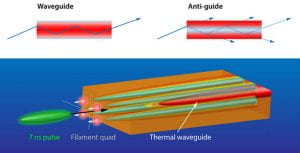Heated air expanding in the wake of an array of laser filaments can guide light signals in a long-lived atmospheric “optical fiber.”
Femtosecond filaments arise from interplay between nonlinear self-focusing of ultrashort pulse laser beams in transparent media (such as air) and defocusing by field ionized plasma, resulting in a region of high laser intensity which propagates over long distances. Research into femtosecond filaments has explored applications such as triggering of high voltage breakdowns, remote spectroscopy such as LIDAR and LIBS, and generation of super broadband coherent spectra. We have shown that by exploiting the strongly nonlinear absorption of propagating filament energy by the atmosphere, extremely long-lived waveguide structures can be ‘laser-written’ into the air.
As a filament propagates, the energy deposited in the air cause thermo-acoustic expansion, producing a density and refractive index minimum on axis that lasts for several milliseconds. By arranging multiple filaments in an azimuthal ‘cage’ shape, we imprint an effective waveguide ‘cladding’ surrounding an air ‘core’ of unperturbed density. We demonstrated that this long-lasting air waveguide can guide high peak and average power laser beams.. Our results, published in Phys. Rev. X and highlighted in Physics, pave the way for projecting high energy/power laser pulses over long distances through the atmosphere.
Combination of four individual filaments to guide a high power heater pulse. Image credit: APS/Alan Stonebraker
Just as air waveguides can guide laser pulses, they can also collect remote optical signals. In later work, we demonstrated collection of the emission spectrum from a plasma spark with a ~50% increase in signal: scaling this result to collection distances of ~100 m would result in a signal improvement of 104. To fully characterize the waveguides, our lab also published papers on the shock waves which form them, and the energy deposition during filament propagation.

